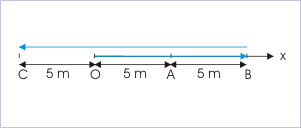| << Chapter < Page | Chapter >> Page > |
One dimensional motion, having only two directions – along or opposite to the positive direction of axis, allows plotting displacement – time graph. One dimensional motion involves only one way of changing direction i.e. the particle under motion can reverse its direction of motion. Any other change of direction is not possible; otherwise the motion would not remain one dimensional motion.
The simplication, in the case of one directional motion, allows us to do away with the need to use vector notation . Instead, the vectors are treated simply as scalars with one qualification that vectors in the direction of chosen reference is considered positive and vectors in the opposite direction to chosen reference is considered negative.
Representation of a displacement vector as a scalar quantity uses following construct :
To illustrate the construct, let us consider a motion of a ball which transverses from O to A to B to C to O along x-axis as shown in the figure.
Rectilinear motion

The magnitude of displacements (in meters) at various points of motion are :
It is important to note from above data that when origin is chosen to coincide with initial position of the particle, then displacement and position vectors are equal.
The data for displacement as obtained above also reveals that by assigning proper sign to a scalar value, we can represent directional attribute of a vector quantity. In other words, plotting magnitude of displacement in one dimension with appropriate sign would completely represent the displacement vector in both magnitude and direction.
There are different difference terms like Δr, Δ| r |, |Δ r | and Δ r , which denote different aspects of change in position. It might appear trivial, but it is the understanding and ability to distinguish these quantities that will enable us to treat and describe motion appropriately in different dimensions. From the discussion so far, we have realized that the symbol "Δ r " denotes displacement, which is equal to the difference in position vectors between "final" and "initial" positions. The meaning of the symbol "|Δ r |" follows from the meaning of "Δ r " as magnitude of displacement.
As a matter of fact, it is the symbol “Δr”, which creates certain "unexpected" confusion or ambiguity – if not handled appropriately. Going by the conventional understanding, we may be tempted to say that “Δr” represents magnitude of displacement and is equal to the absolute value of displacement i.e. |Δ r |. The point that we want to emphasize here is that it is not so.
Going by the plain meaning of the symbol, "Δ", we can interpret two terms as :

Notification Switch
Would you like to follow the 'Physics for k-12' conversation and receive update notifications?